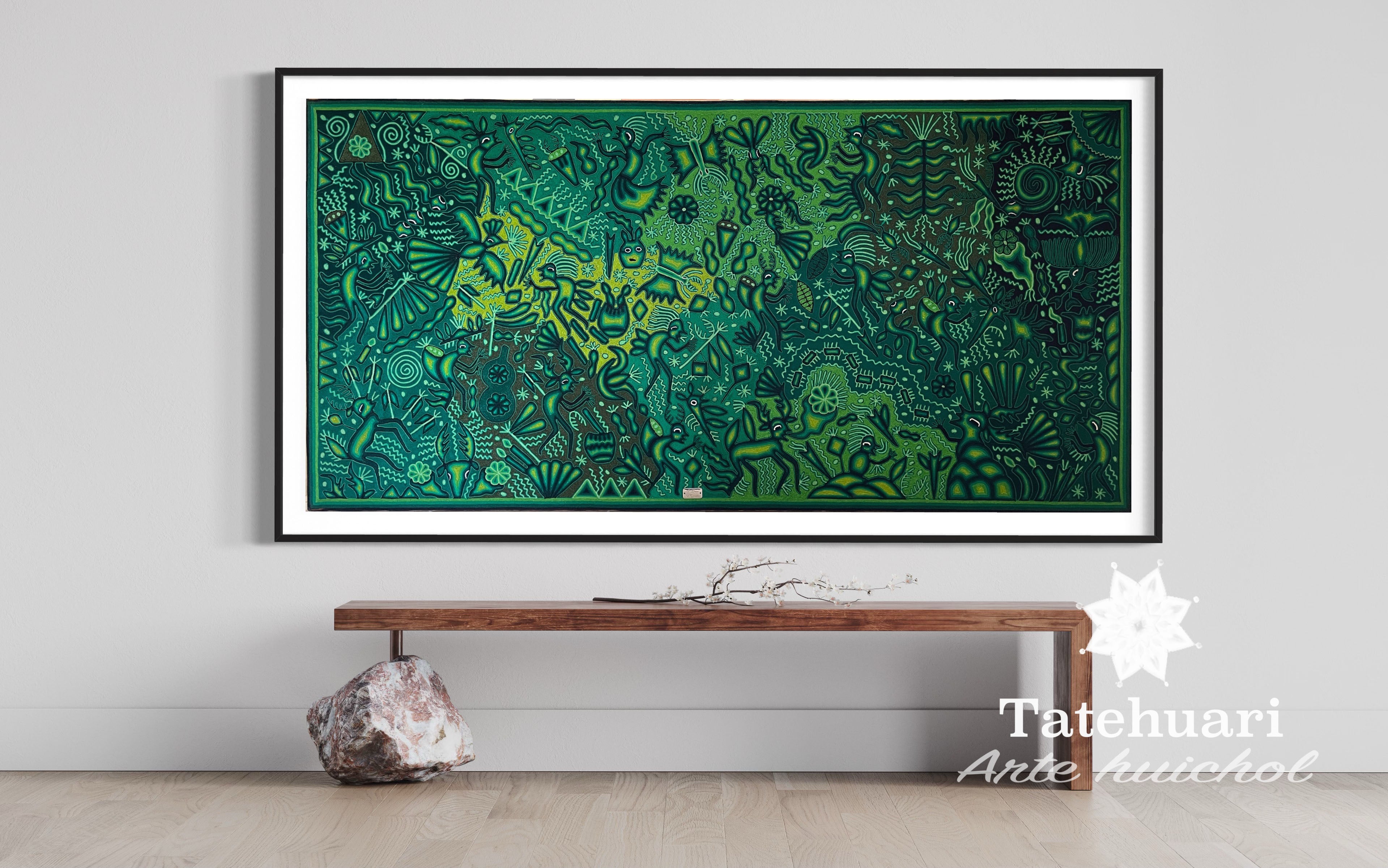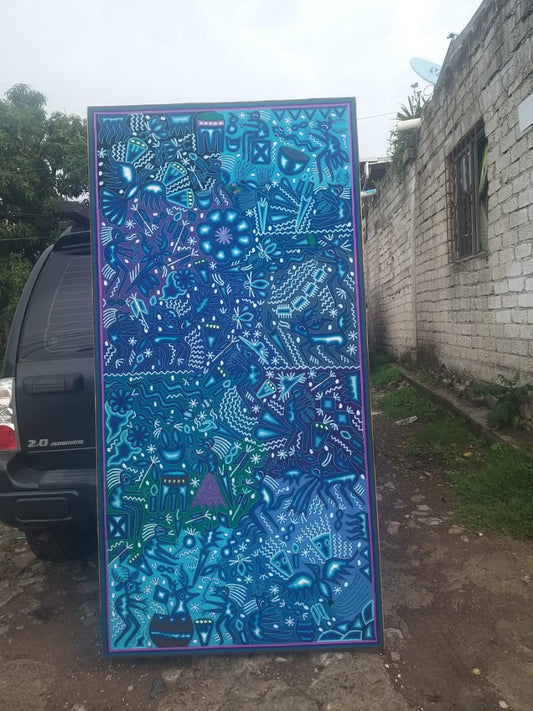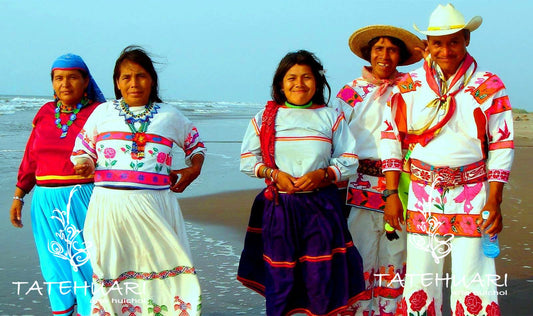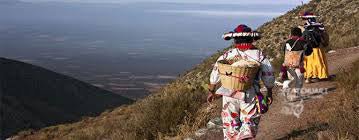Nierika is a trap, a door and a mirror in which the past and the present collide in Wirikuta.
Nierika is a focal point where our ancestors concentrate their energies to reveal themselves and instruct the devotee. It is a meeting point of definitions and beliefs in the Huichol cosmogony; an amalgamation of energy that prolongs the wisdom of the ancestors, and concentrates them on the transcendence of the physical. It is, in other words, an offering that connects the here and now.
A primordial nierika is the snare trap, winiyeri, in which the deer was sacrificed to the disciplined hunter who laid it out on his path among some trees, when it was more abundant. Other nierikate (plural) resemble threads strung symbolically around a wooden wheel.

The openings that penetrate the sacred caves, where Our Ancestors remain in the heart of the Sierra, and the Cerro Quemado, where Our Father emerged from the underworld at dawn, are other nierikate. They are also represented as cavities in stone discs, tepárite, which allow the sun's rays to receive and transmit messages from our ancestors in their shrines to the seven surrounding points: the four cardinal points and the center on this plane, and the sub world. -terrestrial or formative contrasted to celestial. There is a tepari behind each shrine and above its entrance another with openings as a window on the door; another tepari can be inside, covering or serving as an altar for some image corresponding to a standing ancestor, memuú. The transcendental perception, nierika, that healer shamans have allows them to diagnose the cause of a disease and locate its source in the body of the sick person.
For the peyote guardians, nierika symbolizes several important elements of nature: a snare trap that seeks to reach the blue deer, and in which the disciplined hunter who laid it out along the path is sacrificed; some cavities in stone discs –of tepárite– that are placed both in the sacred caves –there where the Ancestors lie in the heart of the
Sierra, as in the El Quemado hill, place of origin of the Father of the underworld at dawn. These caverns represent the seven surrounding points: the four cardinal points, the center on this plane, the subterrestrial world and the celestial world, and a reflection of the ancestors in the painted faces of the pilgrims on the Wirikuta gates.
For the peyote guardians, nierika symbolizes several important elements of nature: a snare trap that seeks to reach the blue deer, and in which the disciplined hunter who laid it out along the path is sacrificed; some cavities in stone discs –of tepárite– that are placed both in the sacred caves –there where the Ancestors lie in the heart of the
Sierra, as in the El Quemado hill, place of origin of the Father of the underworld at dawn. These caverns represent the seven surrounding points: the four cardinal points, the center on this plane, the subterrestrial world and the celestial world, and a reflection of the ancestors in the painted faces of the pilgrims on the Wirikuta gates.
The pilgrim and the shamans carry a round mirror, called a nierika, in their petaquin, to draw their faces with the icons of the ancestor whose name they represent during a five-year cycle. The pilgrim's face painted in yellow is a nierika, that is, a reflection of the ancestor whose path is followed because it has been consecrated by the rays of Our Father who dawns in the east, whose face is visible thanks to the sacrifice of Our Big Brother Venadito del Sun or Our Mother Peyote.
A 'frontal shield' is another meaning of nierika, according to the first serious researcher of the Huichol, the Norwegian Lumholtz at the end of the nineteenth century. Shields have long served as defensive instruments in combat offensives, but the idea persists that a shield needs to be maintained against temptations or distractions on the ritual path.
Lumholtz also wrote that the word nierika means a sacred drawing, apparition, or representation, and applied it to some of the votive objects that are still in use today. These oval votive offerings symbolize some aspects of an ancestor and corresponding prayers. To date, flattened wooden boards continue to be used; its figures are drawn with glass beads or yarn threads, being glued on the wood by means of rustic beeswax from 'Campeche'. Since the end of the 20th century, they began to make some drawing on paper, which could be called wewiya, instead of nierika. When the image is not of a circular type, it can be an itari, or a petate laid out to rest and pray to an ancestor in the sacred center of the coamil, which is his nierika.
Not widely seen today are the elaborately woven pieces of wood, called nama, which Lumholtz described as a 'back shield' and hung from arrows like a nierika. These were square and recall the shape of today's worsted squares. Nierika as an offering to Our Mother the Sea Our Oracular Great-grandmother, Takutsi Nakawé, is the oldest of the ancestors and wise by her anticipated knowledge. She is characterized by her mask, called nierika, which reveals her androgynous personality, masculine in some facial features and feminine in her skirt. His masculine aspect is the primordial fire, Nauru.
The word nierika comes from the verb to see, nieriya. Votive objects become visible when they have been smeared with the blood of a sacrificed animal, then they are effective in conveying your invocations to the ancestor in question.
Nierika is also a mirror that reflects the images of our ancestors for the pilgrims at the Wirikuta gates, where our ancestors draw icons on their faces. First the pilgrims deposit offerings of votive gourds, xukúrite, symbols of the womb, and they carry sacred water from the oasis of
Our Mother who Looks at us from Below, source of fertility, Tatei Matinieri. Then they paint their faces with a yellow root near another oasis, Tuimayau, which must have long served as a mirror. Once the pilgrims have purified themselves through days of fasting and confessing their sexual sins, they arrive at Wirikuta where they hunt the sacred deer that offers its peyote-shaped heart to the one who follows its visionary trail. Likewise, peyote, hikuri, is itself a source of nierika and symbolizes the concept of nierika.
#Nierikas #tablasdestambre #yarnpaintings #artesaniahuichol #ventadeartehuichol




